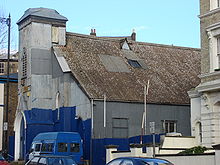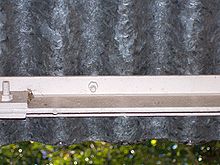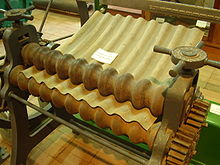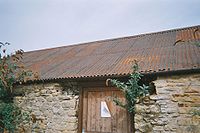- Corrugated galvanised iron
-
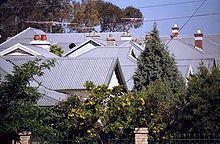 Corrugated galvanised iron roofing in Mount Lawley, Western Australia.
Corrugated galvanised iron roofing in Mount Lawley, Western Australia.
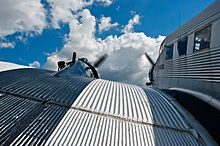 Corrugated Duraluminium covering Ju52.
Corrugated Duraluminium covering Ju52.
Corrugated galvanised iron (colloquially corrugated iron or pailing (in Caribbean English), commonly abbreviated CGI) is a building material composed of sheets of hot-dip galvanised mild steel, cold-rolled to produce a linear corrugated pattern in them. The corrugations increase the bending strength of the sheet in the direction perpendicular to the corrugations, but not parallel to them. Normally each sheet is manufactured longer in its strong direction.
CGI is lightweight and easily transported. It was and still is widely used especially in rural and military buildings such as sheds and water tanks. Its unique properties were used in the development of countries like Australia from the 1840s, and it is still helping developing countries today.
Contents
History
Early manual corrugated iron roller. On display at Kapunda museum, South Australia
CGI was invented in the 1820s in Britain by Henry Palmer, architect and engineer to the London Dock Company. It was originally made (as the name suggests) from wrought iron. It proved to be light, strong, corrosion-resistant, and easily transported, and particularly lent itself to prefabricated structures and improvisation by semi-skilled workers. It soon became a common construction material in rural areas in the United States, Chile, New Zealand and Australia and later India, and in Australia and Chile also became (and remains) the most common roofing material even in urban areas. In Australia and New Zealand particularly it has become part of the cultural identity,[1][2][3] and fashionable architectural use has become common.[4]
For roofing purposes, the sheets are laid somewhat like tiles, with a lateral overlap of two or three corrugations, and a vertical overlap of about 150 mm, to provide for waterproofing. CGI is also a common construction material for industrial buildings throughout the world.
Wrought iron CGI was gradually replaced by mild steel from around the 1890s, and iron CGI is no longer obtainable - however, the common name has not been changed. Galvanized sheets with simple corrugations are also being gradually displaced by 55% Al-Zn coated steel[5] or coil-painted sheets with complex profiles. However CGI remains common.
Corrugation today
Today the corrugation process is carried out using the process of "Roll Forming". This modern process is highly automated to achieve high productivity and low costs associated with labour. In the corrugation process sheet metal is pulled off huge rolls and through rolling dies that form the corrugation. After the sheet metal passes through the rollers it is automatically sheared off at a desired length. The standard shape of corrugated material is the round wavy style, but can be easily modified to a variety of shapes and sizes by simply changing the dies [4].
Many materials today undergo the corrugation process. The most common materials are ferrous alloys but may also span to stainless steels. Copper and aluminium are also used. Regular ferrous alloys are the most common due to price and availability. Common sizes of corrugated material can range from a very thin 30 gauge (.012 inches = 0.305 mm) to a relatively thick 6 gauge (.1943 inches = 4.94 mm). Thicker or thinner gauges may also be produced.
Other materials such as plastic and fibreglass are also given the corrugated look. Many applications are available for these products including using them with metal sheets to allow light to penetrate below. However, these sheets are not formed through the corrugation process.
Pitch and depth
The corrugations are described in terms of pitch (the distance between two crests) and depth (the height from the top of a crest to the bottom of a trough). It is important for the pitch and depth to be quite uniform, in order for the sheets to be easily stackable for transport, and to overlap neatly when making a join. Pitches have ranged from 25 mm (1 inch) to 125 mm (5 inches). It was once common for CGI used for vertical walls to have a shorter pitch and depth than roofing CGI. This shorter pitched material was sometimes called "rippled" instead of "corrugated". However nowadays, nearly all CGI produced has the same pitch of 3 inches (76 mm).
Echo
Clapping hands or snapping ones fingers whilst standing next to perpendicular sheets of corrugated iron (for example, in a fence) will produce a high-pitched echo with a rapidly falling pitch. This is due to a sequence of echoes from adjacent corrugations.
If sound is traveling at 344 m/s and the corrugated iron has a wavelength (pitch) of 3” or .0762m this will produce an echo with a maximum wavelength of that order, which corresponds to a frequency of 4500 Hz or so (approximately the C above top A on a standard piano). The first part of the echo will have a much higher pitch because the sound impulses from iron nearly opposite the clapper will arrive almost simultaneously.
Corrosion
Although galvanising inhibits corrosion of the underlying steel, rusting will be inevitable, especially if the local rainfall is at all acidic in nature. So for example, corrugated iron sheet roofing will start to degrade within a few years despite the protective action of the zinc coating in corroding preferentially. Other environments which lower the lifetime of galvanised iron roofs and similar products includes marine locations, where the high electrical conductivity of sea water will encourage and increase the rate of attack. Nevertheless, corrugated steel roofs can last for many years if further protected by a paint layer.
See also
References
- ^ [1]
- ^ [2]
- ^ [ISBN 9781877338700, Wrinkly Tin: The Story of Corrugated Iron in New Zealand]
- ^ " Glenn Murcutt is Australia's most internationally famous architect...."
- ^ [3] GALVALUME steel
External links
Categories:- Steels
- Building materials
- Australian culture
- Barbadian architecture
Wikimedia Foundation. 2010.

